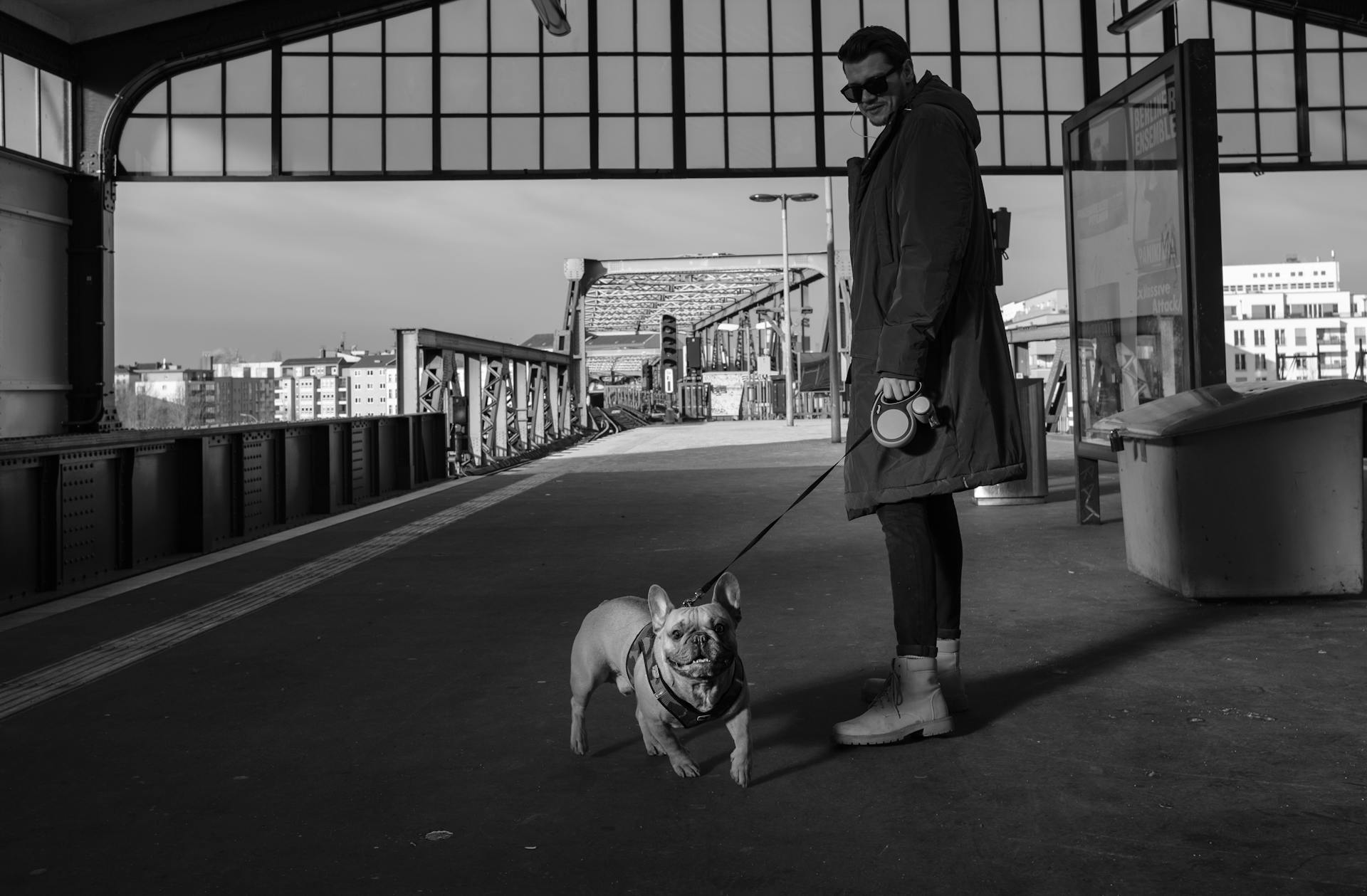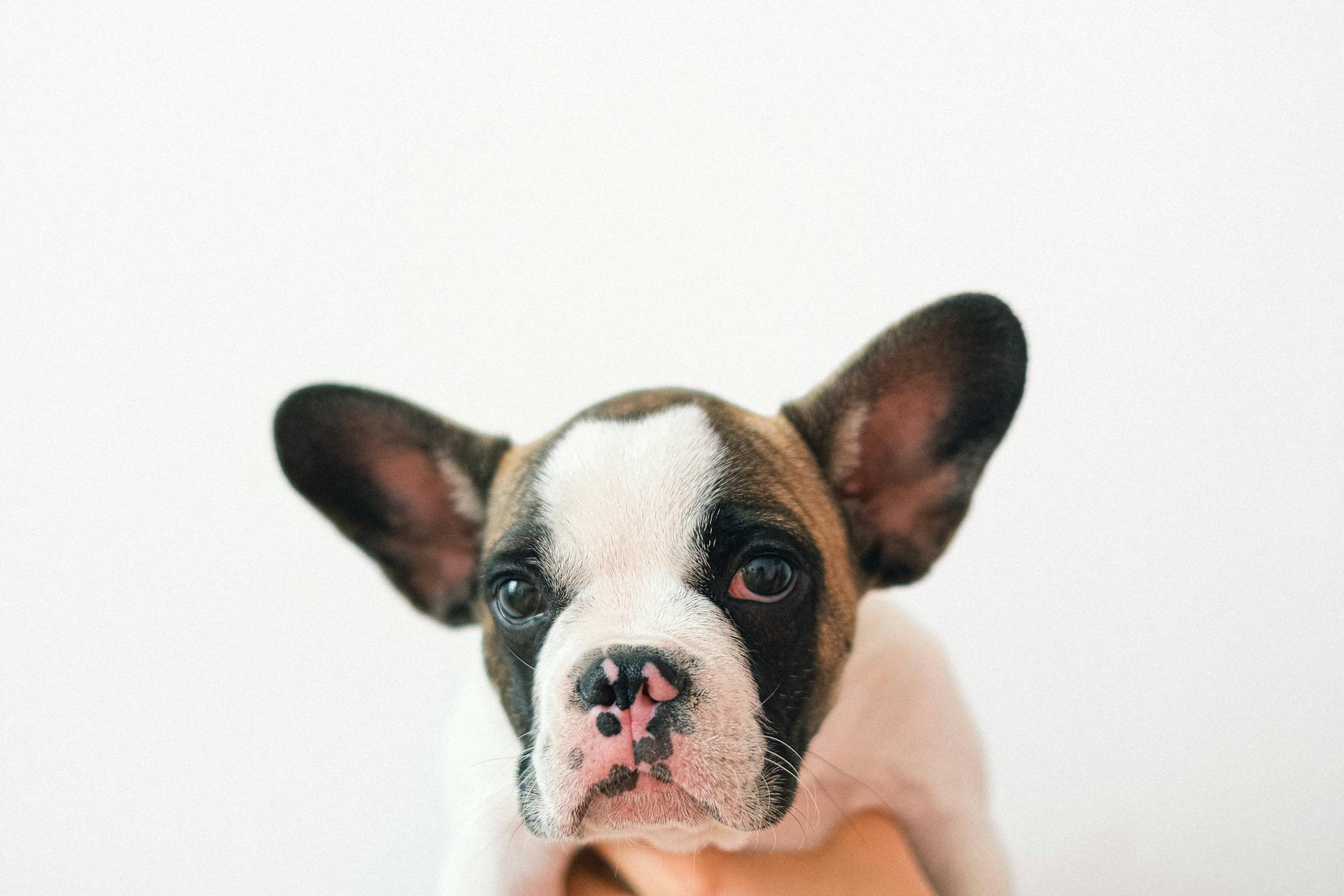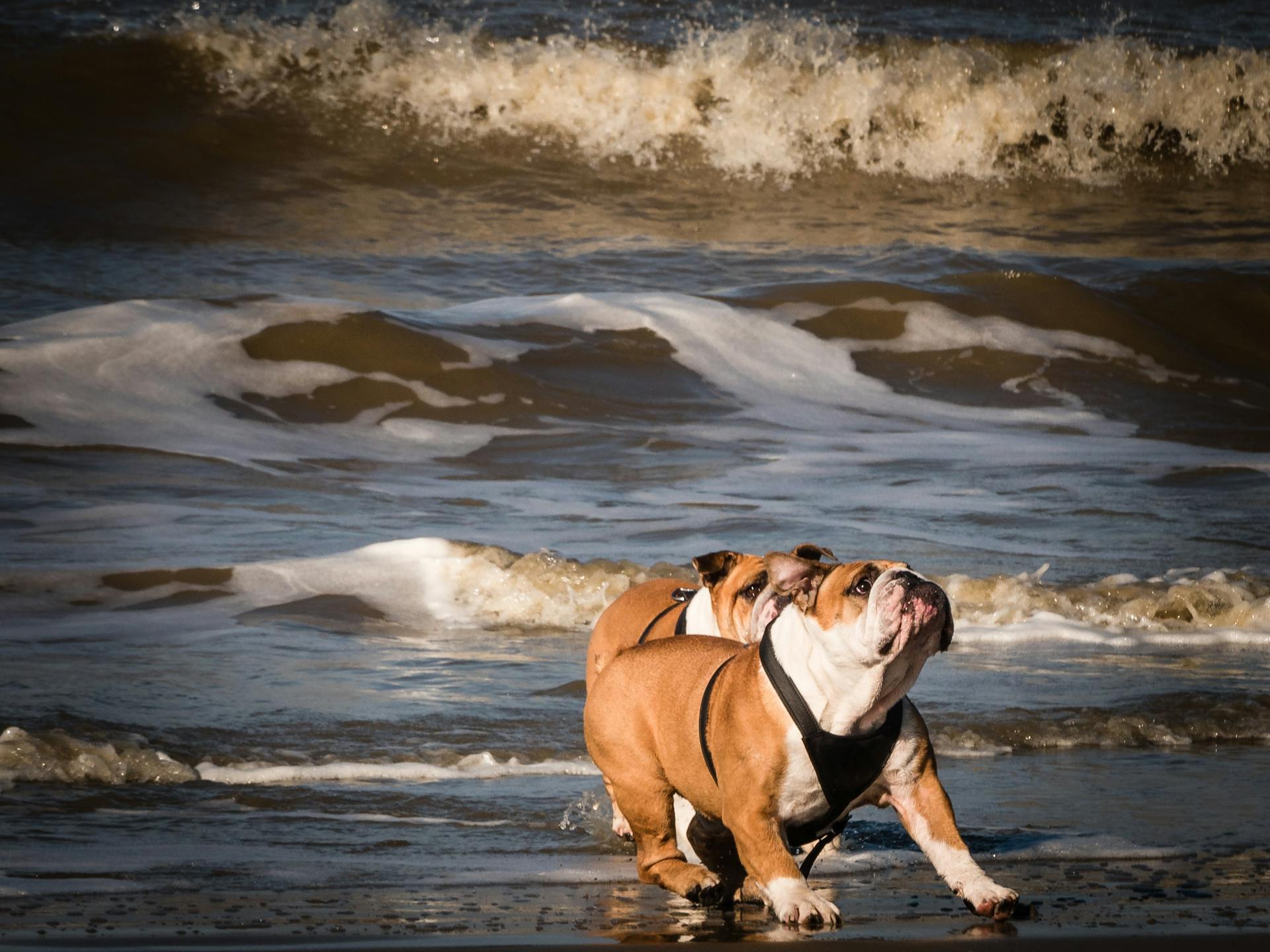
English Bulldogs are known for their laid-back and affectionate nature, but they can also be stubborn at times.
They are generally quiet dogs, with some owners reporting that they rarely bark.
One key thing to remember is that English Bulldogs are not high-energy dogs and don't require a lot of exercise.
They are happy with short, gentle walks and playtime, making them a great fit for city living.
Their calm demeanor makes them a great companion for families with children.
For more insights, see: Great Dane English Bulldog Mix
English Bulldog Temperament
English Bulldogs are known for being gentle, sweet, dependable, and relatively predictable. They're great with kids and enjoy human attention, making them perfect family dogs.
Bulldogs are also courageous and make excellent watchdogs, thanks to their history of being bred for bull-baiting. However, they can be aggressive to dogs they don't know without proper training and socialization.
English Bulldogs are typically friendly, loyal, and good with other pets and children, but they do have an independent streak that can make them stubborn at times. Consistency in training and positive reinforcement techniques can help address this issue.
Personality and Behavior
English Bulldogs are known for their gentle and affectionate nature, making them a great addition to families with kids. They're also social animals who thrive on companionship and love to cuddle.
Bulldogs can be courageous and protective when necessary, but they're generally friendly and approachable, making them excellent family pets. They're known to be good with other pets, but can be aggressive to dogs they don't know without proper training and socialization.
Their independent streak means they can be a bit stubborn at times, but with consistent training and positive reinforcement, they can learn to sit, stay, and behave well in public. Bulldogs need to be well-trained and socialized to be confident and well-mannered.
Bulldogs benefit from daily exercise, but they don't need a significant amount of it. Short, leashed walks in a cool environment are recommended, especially for those with breathing issues. A game of fetch inside or a puzzle toy can also be a great way to keep them active and engaged.
English Bulldogs can seem a bit domineering, but this can be easily addressed by teaching them what to do instead, using positive reinforcement techniques. Consistency is key in teaching them appropriate behaviors, and feeding them separately from other animals can prevent territorial or guarding behaviors.
Changes Over Time
The English Bulldog has undergone significant changes over time, transforming from a physically capable breed to a more companionable one. Modern English Bulldogs have shorter legs and a heavier body.
Their calm and patient demeanor makes them an excellent choice for a family pet. They're loyal and protective of their family, but not as physically capable as their ancestors.
In the 20th and 21st centuries, the English Bulldog's popularity increased, leading to overbreeding. This resulted in more prevalent health issues due to the desire for an excessively flat face and wrinkles.
The British Kennel Club revised their English Bulldog standards in 2009 to encourage healthier Bulldogs. Unfortunately, the American Kennel Club and the Bulldog Club of America haven't followed suit.
Their wrinkles and drooly jowls may be adorable, but they originally served a gruesome purpose: diverting blood and sweat away from the Bulldog's eyes during bull baiting.
Here's an interesting read: English Bulldog Wrinkles
History and Origin
The English Bulldog's history is a fascinating one. Originally bred in England as a cross between the Mastiff and the Pug, they were created for the gruesome sport of bull-baiting.
Their ancestors, Alaunts, were ancient Roman working and military dogs, and it's believed that they're also the forebearers to the mastiff breeds. These "broad-mouthed" dogs were used as butchers' dogs to bring livestock to slaughter.
The breed was refined over time, with a focus on characteristics that allowed them to participate in bull-baiting. They developed a wide mouth and strong jaws, a shorter and stockier body that helped prevent injury, and a tenacious spirit that kept them going no matter what.
Their popularity decreased after bull-baiting was banned in the 1830s, but devoted breeders intervened to save the breed. They selectively bred to replace the original ferocity with a more gentle disposition, creating the affectionate companions we know today.
Olde
The "Olde" in Olde English Bulldogge refers to their heritage, which is a mix of breeds including the Bulldog, American Pit Bull Terrier, Bullmastiff, and American Bulldog. This unique blend of bloodlines gives them a distinct appearance and personality.

Olde English Bulldogges have a sturdy build, with thick, powerful necks and stocky legs. Their athletic ability is a notable characteristic, allowing them to keep up with active owners.
Their short, coarse coat comes in a range of solid colors, from fawn to black and white. This makes them a versatile breed that can fit in with many different lifestyles.
Origin & History
The English Bulldog's history dates back centuries, and it's fascinating to learn about its origins.
The breed's ancestors date back to ancient Greece and Rome, where they were used for various purposes.
In England, Bulldogs were originally bred as a cross between the Mastiff and the Pug, specifically for bull-baiting, a gruesome sport that involved dogs attacking bulls.
Bull-baiting was a popular pastime in the Middle Ages, and Bulldogs were prized for their muscular strength, tenacious spirit, and courage.
After bull-baiting was banned in the 1830s, the Bulldog's popularity decreased, and the breed was almost extinct.

However, dedicated breeders intervened, transforming Bulldogs into the gentle, affectionate companions we know today.
The Bulldog Club of England formed in 1878, and the breed was officially recognized by the American Kennel Club in 1886.
The breed's transformation from a ferocious fighting dog to a loving companion is a testament to the power of selective breeding.
Related reading: American Kennel Club Lancashire Heeler
Training and Exercise
Early socialization and puppy training classes are essential for English Bulldogs to grow into well-adjusted adult dogs. Consistent routines, including feeding schedules, outdoor time, and training routines, will help your Bulldog learn quickly what's expected of them.
Establishing a daily routine will make training much easier, so make sure to stick to it. Bulldogs need regular outdoor time and walks, but they're not very active, so keep exercise moderate.
Here are some fun activities to consider:
- Walks
- Backyard and indoor play
- Tug-of-war
- Cuddling and snoozing
Avoid taking your Bulldog out during hot weather, as their short muzzles make breathing difficult. Limit walks to short outings in the early morning and evening when the temperature is over 75 degrees Fahrenheit.
Additional reading: Ruby Short Hair Cavalier King Charles Spaniel
Training

Establishing a consistent routine is key to training your Bulldog. This includes setting a regular feeding schedule, making time for outdoor activities, and sticking to a training routine.
A consistent routine helps your Bulldog learn quickly what is expected of them in your home. This makes the rest of the training much easier.
Early socialization and puppy training classes are highly recommended to curb any undesirable behaviors and help your Bulldog grow into a well-adjusted adult dog.
Proper socialization is essential for your Bulldog's socialization, especially when it comes to new sights, sounds, people, dogs, and other animals.
Exercise
Exercise is a crucial part of any dog's life, and English Bulldogs are no exception. However, they don't require as much physical activity as some other breeds.
English Bulldogs prefer leisurely activities, and short daily walks are a great way to keep them physically and mentally stimulated. They also enjoy play sessions and interactive games.

To prevent overheating and respiratory distress, it's essential to avoid excessive exercise, especially in hot or humid weather. Supervised outdoor time in a secure, shaded area allows Bulldogs to safely explore and enjoy the fresh air.
Here are some fun activities that Bulldogs enjoy:
- Walks
- Backyard and indoor play
- Tug-of-war
- Cuddling and snoozing
Bulldogs are not natural swimmers and should never be allowed in water that is more than elbow deep without supervision and a life jacket. They also have trouble with stairs, so it's best to avoid them altogether.
In extreme heat, it's best to limit your Bulldog's walks to short outings in the early morning and evening to avoid the heat of the day. Providing them with access to cool, air-conditioned space is also essential to ensure they can breathe comfortably.
For more insights, see: English Bulldog in Heat
Puppies
Puppies are adorable bundles of boundless curiosity and energy. They are very playful, tiring themselves out enough to take many naps during the day.
If you're considering getting a puppy, you'll want to make sure you're prepared for the extra energy and attention they require. Purebred puppies, like Bulldog puppies, need to be obtained from reputable breeders or rescue organizations focused on the specific breed.
Puppies need plenty of exercise and mental stimulation to stay happy and healthy. This can be as simple as a daily walk or playtime in the yard.
Bulldog puppies, in particular, are known for their playful nature and need to be kept active to prevent boredom and destructive behavior.
Living with English Bulldogs
Living with English Bulldogs can be a wonderful experience, but it's essential to understand their unique needs. They thrive best in temperate climates.
English Bulldogs don't require a yard, making them great for city dwellers, but they can't keep up with an active lifestyle. They love to relax at home with their owners.
These dogs are not known to be barkers, but they can make lots of noises, especially when they're sleeping. You'll hear snorting, wheezing, and snoring sounds.
Their short muzzle causes breathing difficulties, which can lead to excessive drooling. Be prepared for slobbery kisses!
To keep your Bulldog happy and healthy, provide plenty of durable toys and ropes to chew on. Teach them what's acceptable to chew on and what's not.
Living with an English Bulldog requires patience and understanding of their limitations. With the right care and attention, they can become loving and loyal companions.
Pet Compatibility
Bulldogs are social animals who thrive on companionship and are often referred to as “lap dogs” due to their love of cuddling.
They can form strong bonds with their families and are generally friendly and approachable, making them excellent family pets.
In general, Bulldogs tend to be sociable dogs and can get along well with other pets, including cats and other breeds of dogs.
However, Bulldogs have a strong prey drive, so it’s essential to supervise interactions with smaller pets like rabbits, guinea pigs, or birds.
Bulldogs may display dominant behavior, especially towards dogs of the same sex, so proper introductions and monitoring are crucial when introducing them to new canine buddies.
Pet Care Considerations
English Bulldogs require lifelong medical care due to potential health issues. They may need surgical intervention or a referral to a specialist veterinarian.
Bulldogs are sensitive to heat, which means they need to stay cool in hot weather. This can be managed with plenty of shade and cool water.
Their weight management requirements are crucial, as they can easily become overweight. Regular exercise and a balanced diet are essential to maintain a healthy weight.
Grooming needs are also a consideration, as Bulldogs require regular cleaning of their wrinkles and face. This helps prevent skin infections and other health problems.
Pet parents who are knowledgeable about the breed and ready to meet a Bulldog's needs will find a loving companion.
Good for Families?
English bulldogs can make wonderful family pets under the right circumstances.
Their loving, gentle, and loyal nature makes them great companions for families.
Bulldogs usually have a calm demeanor indoors, which is a big plus for family life.
It's essential to supervise interactions between bulldogs and young children, as with any dog, to ensure both the dog and the child are comfortable and safe.
English Bulldog Health and Behavior
English Bulldogs are known to be gentle and sweet, making them a great fit for families with kids. They're also relatively predictable, which is a plus for first-time dog owners.
They were originally bred for bull-baiting, so they're naturally courageous and make excellent watchdogs. This means they can be a bit aggressive to dogs they don't know without proper training and socialization.
Their slow, lumbering gait is a magnet for attention, and their sweet disposition and goofy antics make for constant entertainment. This is especially true when they're out and about with their family, socializing with people and other pets.
English Bulldogs are loving and dependable, with a bit of an independent streak - once they set their mind on something, it takes a lot of convincing to change it. This can be a challenge for owners, but it's also part of their charm.
They enjoy meeting people almost as much as they love a long nap on the couch, which is a great combination for a family pet.
English Bulldog Fun Facts and Myths
Despite their tough exterior, English Bulldogs are not natural swimmers. Their flat faces, broad heavy chest, and short legs make swimming difficult if not impossible. Make sure your Bulldog wears a life vest when around water!
Here are some fun facts about English Bulldogs that'll make you love them even more:
- English Bulldogs are medium-sized, weighing between 40 and 50 pounds.
- They come in a variety of coat colors and patterns, from tri-colored to dual-colored or completely white.
- Otto, an English Bulldog in Peru, holds a Guinness World Record for skateboarding through the longest human tunnel.
Fun Facts About
English Bulldogs are a beloved breed for many reasons, and one of them is their tenacity, loyalty, and never-give-up attitude. This is probably why over 40 universities use the Bulldog as their mascot, as well as other organizations, including the United States Marine Corps.
You might be surprised to know that Winston Churchill was known as the British Bulldog, but he never actually owned an English Bulldog - he had miniature poodles instead.
English Bulldogs are quite the record-breakers, and one notable example is Otto, an English Bulldog in Peru, who holds a Guinness World Record for skateboarding through the longest human tunnel. He made his way through the 30-person tunnel like a pro.
Due to their large heads, nearly all of English Bulldog puppies are born via cesarean section.
English Bulldogs are not natural swimmers. Their flat faces, broad heavy chest, and short legs make swimming difficult if not impossible. Make sure your Bulldog wears a life vest when around water!
Here's a rundown of the different coat colors and patterns you can expect from an English Bulldog: Tri-coloredDual-coloredCompletely white
Fully grown, English Bulldogs typically weigh between 40 and 50 pounds, despite their thick appearance.
Myths vs. Fact
English Bulldogs are often described as stubborn, but it's not entirely true. They're actually motivated by positive reinforcement and consistency in training.
Their ancestors, bulldog and terrier breeds, were bred to work independently and not give up, so some stubbornness is to be expected.
Punishments, whether verbal or physical, can damage the relationship between a Bulldog and their owner and don't work in the long run. They often create long-term behavioral issues.
By focusing on teaching an English Bulldog what to do rather than correcting unwanted behaviors, they'll be well-behaved companions.
Related reading: How Often to Bathe English Bulldog
Frequently Asked Questions
Are Bulldogs high maintenance?
While English Bulldogs are generally easy-going, they require regular skin care and a balanced diet to avoid potential health issues. Moderate exercise and proper care can help prevent common maintenance concerns.
Do English bulldogs like to cuddle?
English Bulldogs love human interaction and thrive on cuddling, which makes them feel happy and loved. Cuddling also helps keep them warm, making it a win-win for both humans and dogs.
Do English bulldogs like to be held?
English Bulldogs love human interaction and physical touch, making them affectionate companions that enjoy being held and cuddled. Holding them can also help keep them warm, a comforting sensation for this breed.
Featured Images: pexels.com

